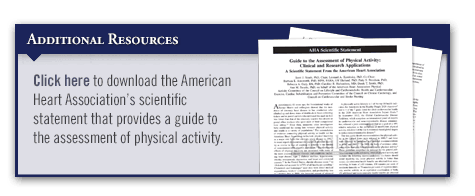Despite the well-established benefits of leading a physically active lifestyle, many adults in the United States are not physically active enough. “There is a need for routine and consistent assessment of physical activity in research and clinical settings in patients with cardiovascular disease (CVD),” says Scott J. Strath, PhD. “Such assessments may improve the identification of risk factors, minimize physical inactivity, and further advance our understanding of the health-related impact.”
Guidance Issued
In 2013, the American Heart Association (AHA) released a scientific statement on assessing physical activity. “The objectives of the AHA statement were to provide the rationale for assessing physical activity, explain the key concepts involved in making these assessments, and offer a roadmap on how to conduct these assessments,” says Dr. Strath, who was lead author of the AHA statement. “Most providers have not routinely assessed physical activity levels because they haven’t had the right tools.”
“Clinicians should be performing physical activity assessments as part of routine medical care along with the other classic risk factors for these diseases.”
The AHA scientific statement features a decision matrix to help providers select the most appropriate assessment method. The matrix includes low-cost or no-cost options, such as questionnaires that patients complete when they arrive for their appointment. “Several issues need to be considered when deciding on ways to assess physical activity levels,” Dr. Strath says. “These include feasibility and practicality of assessments, the availability of resources, and administrative considerations.” The AHA’s decision matrix provides a mechanism for this selection that takes into account all of these factors. The adopted assessment method will vary depending on circumstances because there is no single best instrument that will be appropriate for every situation.
Get Into a Routine
“Clinicians should be performing physical activity assessments as part of routine medical care along with the other classic risk factors for these diseases,” says Dr. Strath. “With this AHA scientific statement, physicians have a blueprint on how best to accomplish these evaluations.” The AHA specifically recommends that an
checkup cover types, frequency, duration, and intensity of physical activity at work, home, and during leisure time. Physicians should also counsel patients on how to include more exercise in their daily lives.
According to Dr. Strath, clinicians must view physical activity assessment as a vital health measure that is tracked regularly over time. “We already assess other major modifiable CVD risk factors with regularity, but physical activity status should also be included,” he says. “We have several assessment methods that can provide reasonably accurate outcome measures and can be adjusted depending on setting-specific resources and constraints. Ultimately, ascertaining this information is a worthwhile effort that should be at the forefront of care.”




 admin
admin